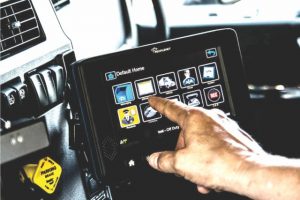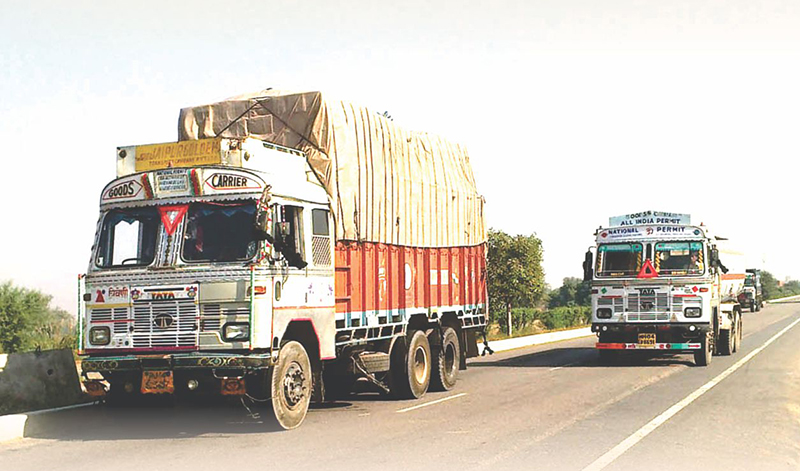India's trucking industry moves one mile at a time for better days
“About 10 percent of the transporters indicated that their overall costs have reduced post-GST implementation, while more than 40 percent suggested that costs were increasing. Higher compliance costs related to GST, due to the technological upgrade, up-skilling of workers, and penalty charges, etc. have added to the cost-burden of transporters, which, coupled with increasing diesel prices, have taken a toll on their profitability.”
If there’s one industry that benefitted the most from India’s unified Goods and Services Tax (GST) in the country’s US$2.4 trillion emerging market economy that would be trucking.
Since the new tax policy was implemented in July of 2017, it has negated the long overdue, multiple and complicated indirect taxes passed on to the supply-chain in the freight handling sector.
India’s market research and credit rating firm ICRA reported truck productivity has increased tremendously since then benefitting as well consumers with their transportation costs cut.
The impact was more felt in Kerala, West Bengal, Maharashtra, Madhya Pradesh, and Bihar, which were earlier known for notoriously high waiting time spent at their inter-state borders, according to the report.
Faster movement of goods
GST, has among others, yielded to a centralized electronic billing mechanism, resulting to faster movement of consumer goods and cost reductions.
“About 10% of the transporters indicated that their overall costs have reduced post-GST implemen-tation, while more than 40% suggested that costs were increasing. Higher compliance costs related to GST, due to the technological upgrade, up-skilling of workers, and penalty charges, etc. have added to the cost-burden of transporters, which, coupled with increasing diesel prices, have taken a toll on their profitability,” the report stated.
With the simplified tax system, long-haul truckers are able to cover 300 to 325 kilometers (186 to 202 miles) a day, compared with an average distance of 225 kilometers a day in the prior period.
Heavily challenged system
Improvements in India’s more efficient trucking services are felt throughout the country among shippers, forwarders and consumers.
But in cities, the need for more technologically advanced trucks is creeping in as the country embraces e-Commerce more which calls for faster deliveries.
India’s current logistics chain is still dependent on the traditional way of doing business which involves manufacturers, logistic companies, warehouses and local delivery companies.
Experts said investments on digitized trucking or trucks built with artificial intelligence to do mapping, on-board telematics, etc., equipped with new safety and comfort features are worth looking into given the country’s economic potentials.
Oliver Wyman, a leading global management consulting firm, said transportation companies normally invest about 5 percent of its revenue on digitalization, with many focusing on mobile apps and solutions to offer a personalized experience for their customers and track the moment of the vehicles accurately.
It described in its report India’s logistics sector as still characterized by grossly incompetent system, low speed of trucks, congested roads and blockage in the surface transport and various other issues.
Sandeep Chatterjee, Senior Manager, Deloitte, can’t agree more. “The Indian trucking industry is highly unorganized and there is a huge influence of trade unions here. Attempt to uberize this industry has not been as successful because of the unorganized nature of the industry. The industry is largely unorganized and fragmented, mainly owing to its operational model and multiple players.”
“The manufacturers/shippers rely heavily on middlemen such as trucking companies and brokers/agents to source the trucks, complete the paperwork, and manage the delivery schedules. Apart from these core tasks, these middlemen are also indirectly responsible for support functions such as financing & insurance, maintenance & repair, and coordination with government/ regulatory bodies,” he added.
 Chatterjee further detailed that “the trucking industry deploys two types of pricing strategies – contract and spot. The former is a quote that is a predetermined amount agreed upon to be with the shipper for certain duration, usually a year..”
Chatterjee further detailed that “the trucking industry deploys two types of pricing strategies – contract and spot. The former is a quote that is a predetermined amount agreed upon to be with the shipper for certain duration, usually a year..”
“A few shippers prefer spot rates as the freight rates fall or rise, according to the demand and load-to-truck ratio. If the demand is low, truck capacity will not be overloaded, resulting in lower prices. Here there is a lot of manipulation and arbitrage which is happening in the current business model.”
Slowly going digital
The good news is that India’s logistics companies are now slowly opening up to the digital world and making efforts change the scenario. The urge to move with time has led the race to modernize and digitalize the operations for smooth running of the company.
Increasing competition, customer demand and competitive market requires implementation of digitalization & data analytics so as to help gain more customers and getting more returns per invest-ments as compared to the other companies.
“To get into the digital model, it is important that we take into account all these stakeholders. Digitization will lead to better prices for the end consumer and remove the middlemen which will have its own backlash. Middlemen costs combined with driver woes, the operational profitability and business productivity takes a severe hit on the shippers as well as the fleet owners,” says Chatterjee.
Some of the advanced services adopted by Logistics Service Providers (LSP) include automated storage and retrieval systems (ASRS) in warehouse and transportation, radio frequency identification (RFID) in the place of bar codes and the Global positioning system for real time tracking.
Ram Menen, retired head of Emirates SkyCargo, enthused, “Apps, GPS, etc., are today’s available tools that speed up transactions and also open up new markets for remote areas worldwide. Geo fencing facilitates quick and efficient access to areas where no proper addresses exist. It also allows people to track their shipments in real time. Carriers as well as consumers benefit from this technology.”
Indian company Kale Logistics Solutions which has found its foothold in the logistics industry in the UAE has come out with digitally enabled cloud based solutions like fleet management solutions (Helios).
This solution is specially designed to enhance the fleet operations and has driven paper based set ups to become more organized and automated.
Through mobile integration, the concept of digitalization has been taken further. Optimum route planning combined with real time tracking of cargo movement through mobile apps enables routing of cargo by avoiding congestion points and troubled spots to minimize risks and interruptions.
This has resulted in the cost reduction and increase in the customer delight and higher business volumes for the truckers. Then there are players like Tech-logistics which apply a wealth of data related to the movement of goods and trucks to identify pattern related to customer trends and unearth market insights to develop industry best solutions.
“It seems technology may be a solution to all these problems. Several startups have jumped into the sector to make transportation easier for all stakeholders and organize the operations. The e-way bill and GST has resulted in increasing the organized nature of the industry but a lot needs to be done,” Chatterjee opined.











